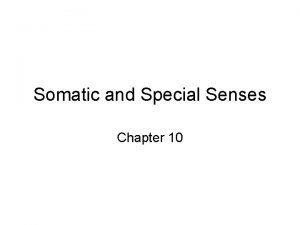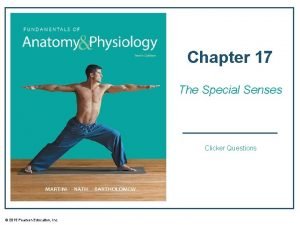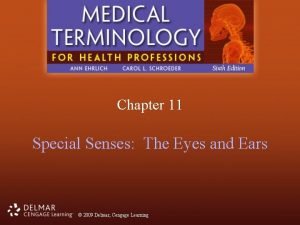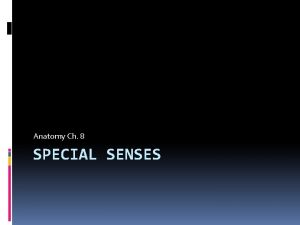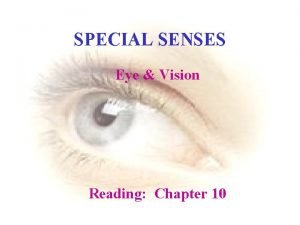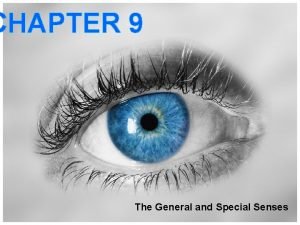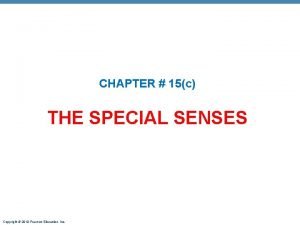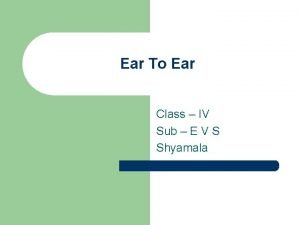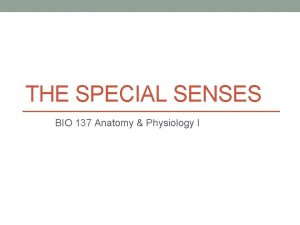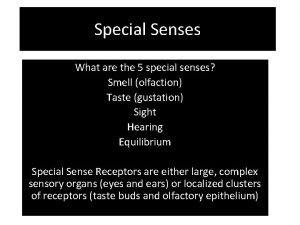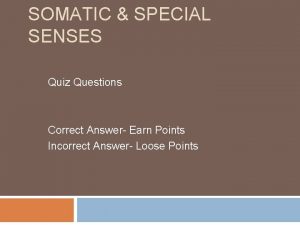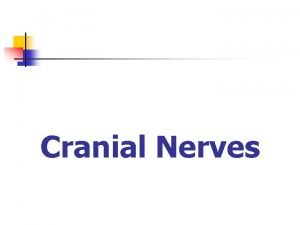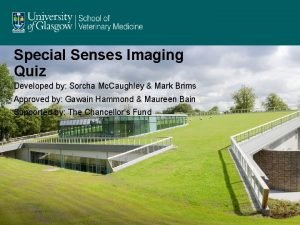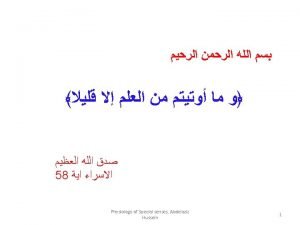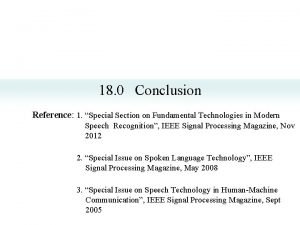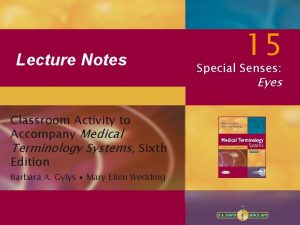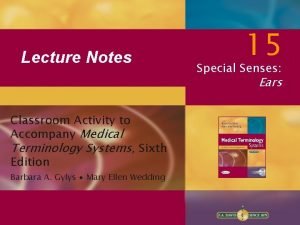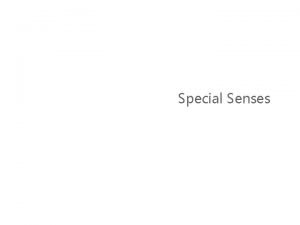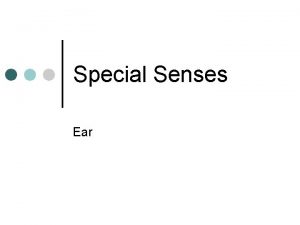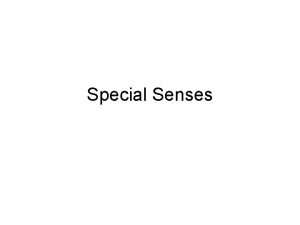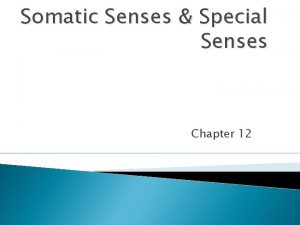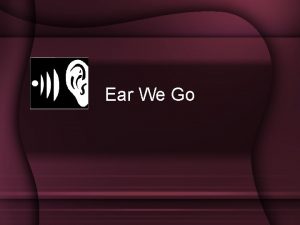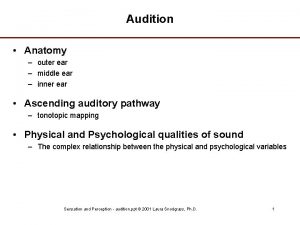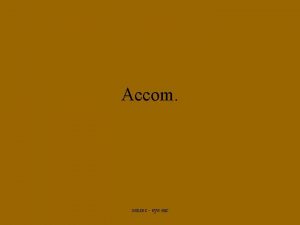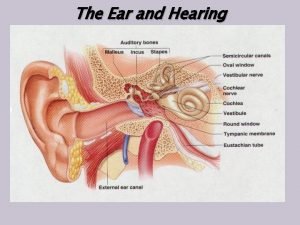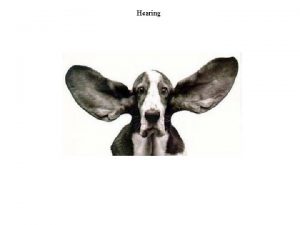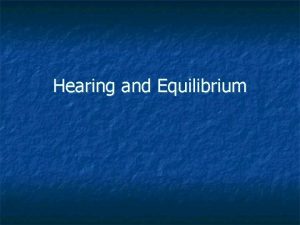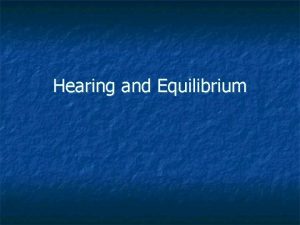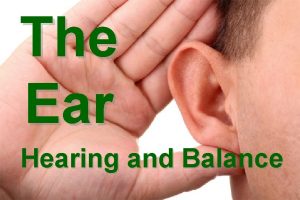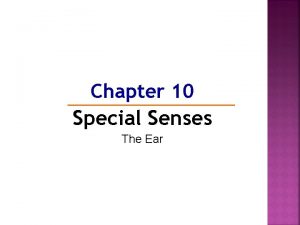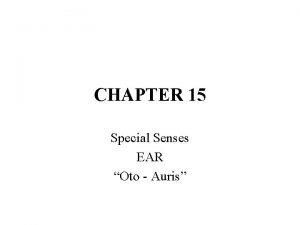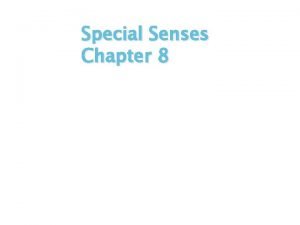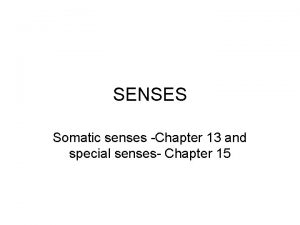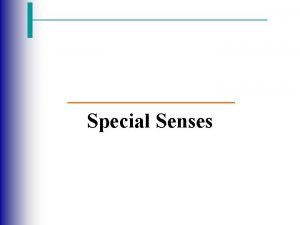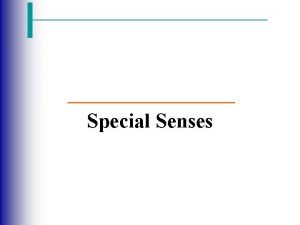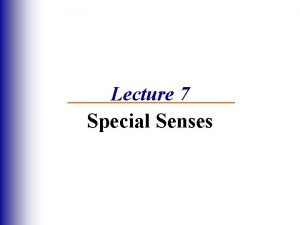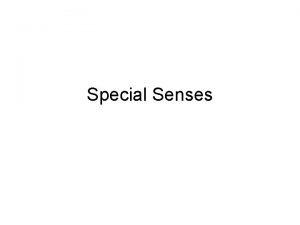Chapter 16 The Special Senses Hearing Outer ear























- Slides: 23

Chapter 16 The Special Senses Hearing

Outer ear La. Pointe Fall ’ 11 Slide # 2 • Anatomy of the ear – External Ear • Auricle or pinnae surrounds the ear • External acoustic meatus (ear canal or auditory canal) • ends on Tympanic membrane (ear drum) • Ceruminous glands - produce cerumen (ear wax)

Middle ear La. Pointe Fall ’ 11 Slide # 3 • Starts with the tympanic membrane • Communicates with pharynx via pharyngotympanic tube (auditory tube, Eustachian tube) • Middle ear encloses and protects the auditory ossicles • malleus, incus, stapes • oval window • tensor tympani muscle - stiffens the malleus and tympanic membrane • stapedius muscle - reduces movement of the stapes on the oval window

Anatomy of the Ear La. Pointe Fall ’ 11 Slide # 4

Middle and Inner Ear La. Pointe Fall ’ 11 Slide # 5 Balance Hearing Figure 15. 25 b

The Middle Ear - Frontal View Lateral La. Pointe Fall ’ 11 Slide # 6 Medial Figure 17. 21

The Middle Ear - Medial View La. Pointe Fall ’ 11 Slide # 7 Figure 15. 26

Inner ear La. Pointe Fall ’ 11 Slide # 8 • Membranous labyrinth contains endolymph (similar to intracellular fluid) • Bony labyrinth surrounds and protects membranous labyrinth • Perilymph lies between the two labyrinths (similar to cerebrospinal fluid) • Vestibular complex • Vestibule - contains the utricle and saccule , sense of gravity, linear acceleration • Semicircular canals - contains semicircular ducts, rotation, equilibrium • Cochlea contains the cochlear duct, sense of hearing

The Inner Ear green = perilymph La. Pointe Fall ’ 11 Slide # 9 blue = endolymph

Chambers of the Cochlea • • The cochlea is divided into three chambers: Scala vestibuli Scala media (chochlear duct) Scala tympani La. Pointe Fall ’ 11 Slide # 10

Perilymph and Endolymph La. Pointe Fall ’ 11 Slide # 11 Scala vestibuli Scala media Scala tympani Figure 17. 28 a

Vibrations of the inner ear La. Pointe Fall ’ 11 Slide # 12 Scala vestibuli (perilymph) Scala media (endolymph) Basilar membrane Scala tympani (perilymph) Tectoral membrane Marieb Figure 15. 34

Sound La. Pointe Fall ’ 11 Slide # 13 • Cochlear duct lies between the vestibular duct and the tympanic duct • Hair cells of the cochlear duct lie within the Organ of Corti • Frequency (cycles per second (Hz)) is determined by which region is stimulated • Intensity is the energy content of a sound, how many hair cells are activated and their degree of movement • Measured in decibels

Windows La. Pointe Fall ’ 11 Slide # 14 • Round window separates the perilymph from the air spaces of the middle ear • Oval window connected to the base of the stapes • Basic receptors of inner ear are hair cells • Contain stereocilia • Provide information about the direction and strength of stimuli

Organ of corti La. Pointe Fall ’ 11 Slide # 15 • Hair cells sit on basilar membrane • Steriocilia are in contact with the tectorial membrane • thin membrane attached to the cochlear duct

The Organ Of Corti (scala media) La. Pointe Fall ’ 11 Slide # 16

Pathway of sound La. Pointe Fall ’ 11 Slide # 17 • Sound waves travel toward tympanic membrane, which vibrates • Auditory ossicles conduct the vibration into the inner ear • Tensor tympani and stapedius muscles contract to reduce the amount of movement when loud sounds arrive • Movement at the oval window applies pressure to the perilymph (in the vestibular duct), and then to the endolymph of the cochlear duct. • Pressure waves distort basilar membrane • Hair cells of the Organ of Corti are pushed against the tectoral membrane

Sound and Hearing La. Pointe Fall ’ 11 Slide # 18 Figure 17. 28 a

Signal amplification La. Pointe Fall ’ 11 Slide # 19

Receptor cell depolarization High K+ solution La. Pointe Fall ’ 11 Slide # 20 High K+ solution K+

Pitch La. Pointe Fall ’ 11 Slide # 21 Figure 15. 32

Neural pathway La. Pointe Fall ’ 11 Slide # 22 • Sensory neurons of hearing are located in the spiral ganglion of the cochlea (first order neuron) • Afferent fibers form the cochlear branch of cranial nerve VIII • Synapse at the cochlear nucleus (second order neuron) • Goes to the inferior colliculus of the mesencephalon (third order neuron) Collaterals go to the olivary nucleus (that fine tunes the ear and adjusts for volume • then to the thalamus (fourth order neuron) • temporal lobe of the cerebral cortex

Neural Pathway (also see fig 16. 18) 4 3 La. Pointe Fall ’ 11 Slide # 23 Note that signals from each ear go to both sides of the brain! 2 1 Figure 15. 34
 What is the difference between somatic and special senses
What is the difference between somatic and special senses Messiners
Messiners Chapter 10 somatic and special senses
Chapter 10 somatic and special senses Chapter 17 special senses answer key
Chapter 17 special senses answer key Chapter 11 labeling exercises
Chapter 11 labeling exercises Anatomy and physiology chapter 8 special senses
Anatomy and physiology chapter 8 special senses Cranucle
Cranucle Emmentropia
Emmentropia The general and special senses chapter 9
The general and special senses chapter 9 Chapter 15 special senses
Chapter 15 special senses Chapter 15 special senses
Chapter 15 special senses Slidetodoc
Slidetodoc Make a collage on animals having external ears
Make a collage on animals having external ears Bio 137
Bio 137 5 basic tastes
5 basic tastes The cones of the retina are coursera quiz answers
The cones of the retina are coursera quiz answers Cranial nerve function mnemonic
Cranial nerve function mnemonic Special senses quiz
Special senses quiz Physiology
Physiology Conclusion of special senses
Conclusion of special senses Building vocabulary activity: the special senses
Building vocabulary activity: the special senses Building vocabulary activity: the special senses
Building vocabulary activity: the special senses Houses the receptors for hearing
Houses the receptors for hearing General and special senses
General and special senses


